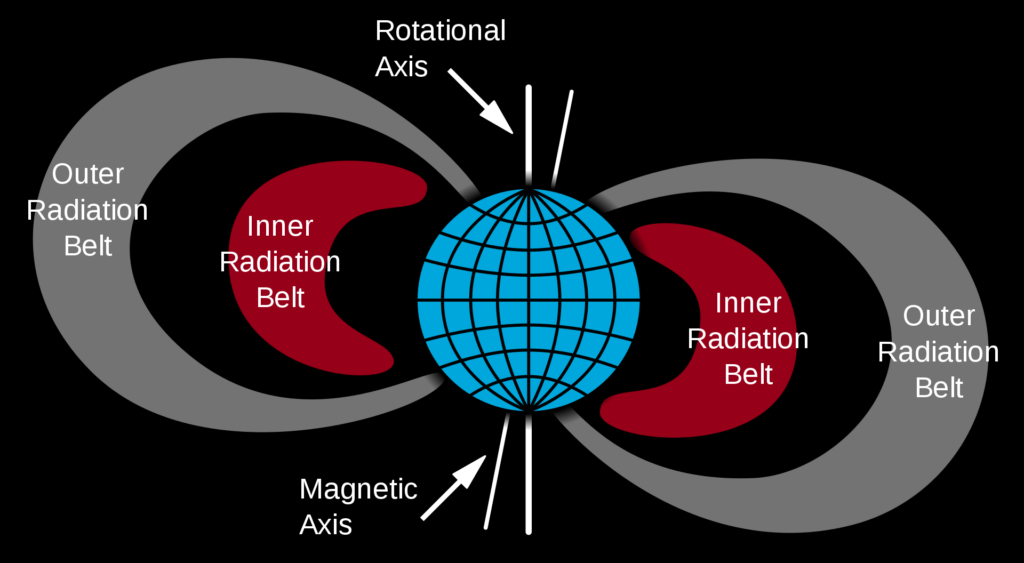The Van Allen radiation belts are semi-toroidal regions where energetic charged particles (mostly electrons and protons) are captured and subject to long-term magnetic trapping by the Earth’s magnetic field. These particles are originated from the interaction of primary Cosmic Rays with the neutral molecules in the upper atmosphere, leading to the production of neutrons which decay into protons, together with electrons and antineutrinos. The resulting motion of these trapped particles is a composition of three different types: a circular motion around the magnetic field lines; a bouncing motion towards the poles, back and forth between two points called “mirror points” where particles reverse their direction; a drift motion around the Earth, where particles “jump” from one field line to a nearby one, with positive ions moving in a westward direction and negative electrons moving eastward.
The Earth presents two such radiation belts – an inner belt and an outer belt, even if sometimes others may be temporarily created. For example, in 2013, NASA reported that the Van Allen Probes had discovered a transient third radiation belt that lasts for about 4 weeks, probably created by a strong Coronal Mass Ejection (CME) that hit the Earth a few days before.
The inner belt extends from an altitude of about 500 km to about 12000 km (or an L-shell value between 1 and 3) but with its boundaries that may change because of strong solar activity. The region where the inner belt comes to be closer to the Earth’s surface (at an altitude of ~ 200 km), approximately located over the South Atlantic Ocean, is known as South Atlantic Anomaly (SAA). It emerges as a consequence of the tilt between the magnetic dipole axis of the Earth and its rotational axis and of the offset between the dipole itself and the Earth’s center. It is characterized by an extremely low intensity of the geomagnetic field and increased flux of energetic particles.
The SAA is very important in the framework of satellites or spacecraft as it exposes them to a strong radiation that may damage integrated circuits and sensors, having a strong impact on space systems design and mission planning. For this reason, the scientific community has been considerably involved in modeling the space radiation environment. The NASA AE9/AP9 set of models for high-energy electrons and protons, respectively, is the most complete and recent effort in describing the radiation environment of near-Earth. These models are based on numerous datasets, obtained from sensors onboard various satellites and processed to create maps of the particle fluxes with different estimated uncertainties due to imperfect measurements and space weather variability.
However, such models can be partially incomplete or based on a statistically insufficient sample of direct measurements.
CSES missions are able to provide precise measurements of proton fluxes in the MeV energy range inside the SAA, allowing for monitoring the radiation environment for the next decades and helping the validation and test of these models. These data are particularly important now that the Van Allen Probes have terminated to transmit data.
The high performance of the on board instruments allows to perform the proton flux estimation by using a multi-dimensional approach, very important due to the extreme anisotropy of trapped protons in this region. Proton candidates are considered as a function of the satellite position (latitude/longitude), energy, pitch angle – i.e. the angle between particle’s direction and the local magnetic field line – and the time that the satellite spends at a particular orientation. In such way, the effective area of the instrument is defined as a function of the particle energy and direction.
From a geomagnetic point of view, a selection on both the magnetic field (B<20500 nT) and L-shell parameter (L < 1.3) is performed to operatively define the SAA region.
RESULTS
